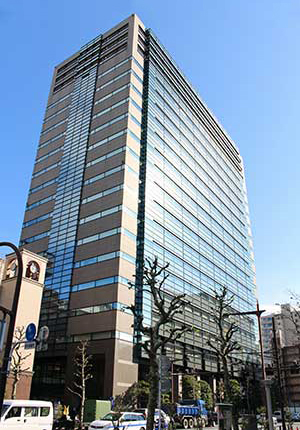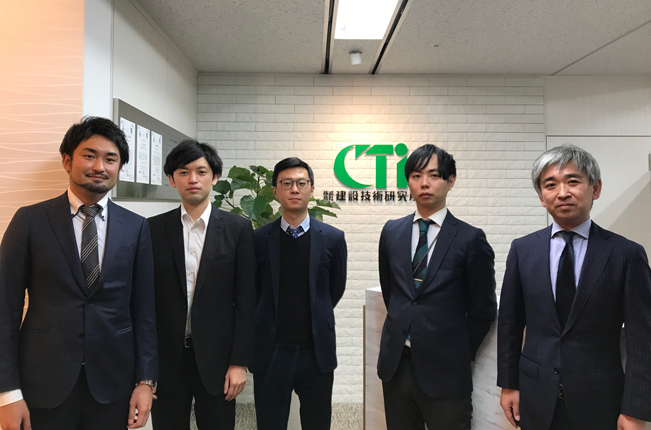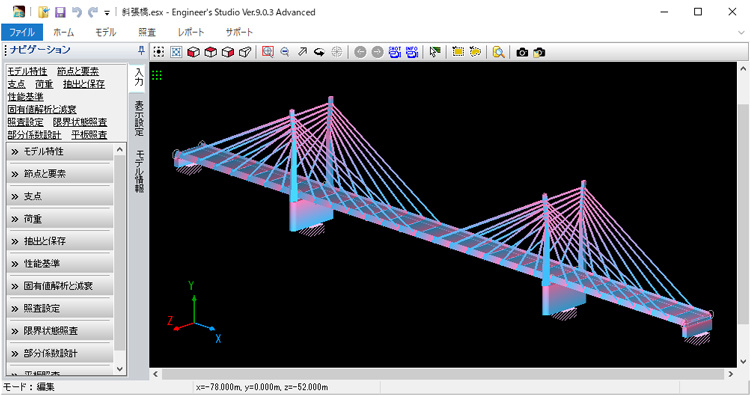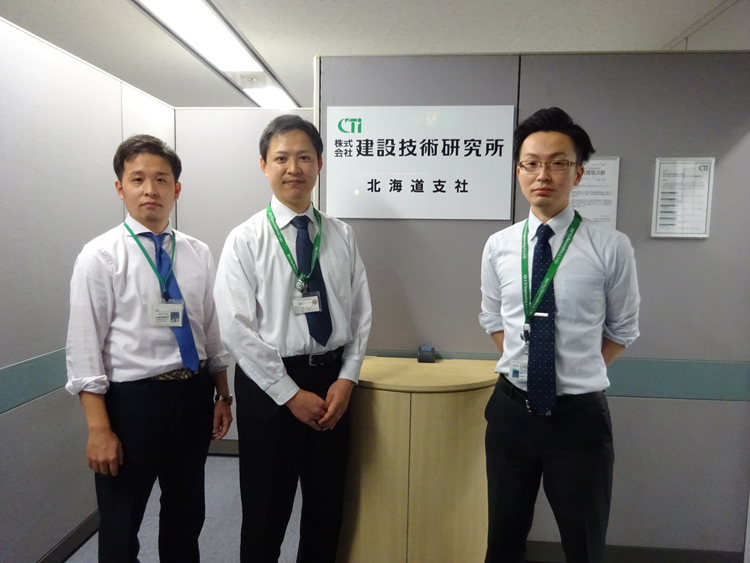|
“As a policy about utilization of information communication technology (ICT), we attach great importance not to asking someone else easily but to operating something by ourselves by actually touching it, partly because there are many young members within the Division.”
In doing so, if, for example, they consider it necessary to get new software programs, enhanced options, or a high-performance personal computer or something to make them run, they make a purchase request to their boss. Representing such a stance, they have come to acquire most of all kinds of licenses of the FORUM8 software programs related to bridge design (UC-1 software) so that they can deal with design of any types of bridge, according to Mr. Hayato Ukai, Chief, Structural Engineering Division, Tokyo Main Office, CTI Engineering Co., Ltd. At present, they are promoting introduction of RPA (Robotic Process Automation) and AI (artificial intelligence) into design as well as provision and utilization of three-dimensional (3D) surveying technologies and BIM/CIM environment. He says that they keep in mind to do more than meet the client's needs while adopting these latest technologies.
In creating drawings, as Mr. Kenta Tanaka, Executive in charge of Hokkaido Waterworks Engineering Section, Hokkaido Office reports, though 2DCAD has been the mainstream, it is gradually getting replaced by 3DCAD in recent years. In addition, such pattern can be widely seen that a pattern that CIM is adopted from the detailed design step. On the other hand, the Company was committed to applying CIM from the initial stage of work including preliminary design or basic design in order to link CIM to more efficient work or advancement of design. He also says that from the view point that technical strength of individual users of the tools including CIM becomes important, the Company is also committed to its own technical training.
Our user to pick up for this issue is Structural Engineering Division, Tokyo Main Office and Hokkaido Waterworks Engineering Section, Hokkaido Office of CTI Engineering Co., Ltd. The former deals with bridge design mainly in Eastern Japan, and the latter takes charge of river structure design in Hokkaido, based in Sapporo. Both have been using design software products that support various fields of “UC-1 series” mainly for many years, and since about 10 years ago, they have been using “Engineer’s Studio®” (ES) for nonlinear dynamic analysis of three-dimensional (3D) laminated plate / cable. They are also highly interested in “3D parametric tool” that FORUM8 is currently developing.
 |
 |
|
[Structural Engineering Division, Tokyo Main Office] from the left: Messrs. Takahiro Mitani, Taiki Yoshida, Lei Gyou, Hayato Ukai, and Masayuki Usui |
Original Approach to Design of Bridges and River Structures Based on Organization Power of General Construction Consultant
It was 1945 that Civil Engineering Research Laboratory: Kensetsu Gijyutsu Kenkyujo was founded as the first construction consultant in Japan. Later, in 1963, it was established as CTI Engineering Co., Ltd. (renamed as it is now in the following year). The Company has been expanding its business centering on areas of rivers and waterworks engineering since its foundation, and also gradually widening its business to a broad range of infrastructure development including roads. Engineers are positioned for all of 21 sections for which registrations of construction consultants are made by Minister of Land, Infrastructure, Transport and Tourism. Currently, under the headquarters situated in Chuo-ku, Tokyo, the Company has established two main offices in Tokyo and Osaka, 8 branches in Hokkaido, Tohoku, Hokuriku, Chubu, Chugoku, Shikoku, Kyushu, and Okinawa, 42 local offices within the areas of head offices and branches, and National Land Culture Institute. With additional 12 group companies in and out of the country, about 3,500 professional engineers are working in a whole group.
Structural Engineering Division, Tokyo Main Office we interviewed this time takes charge of the phase ranging from bridge planning to design. Centering on Eastern Japan, they work on design of new bridges that supports every structural type, aseismic reinforcement design of existing bridges, maintenance and repair design and so on. While their main business comes from the Ministry of Land, Infrastructure, Transport, and Tourism and local governments, they also get more and more works related with large-scale projects such as a long-span bridge or a JCT bridge committed by expressway companies in recent years. As the design conditions become complicated, they have built up a system for proposing an optimal bridge type by collaborating with multiple divisions. Another characteristic of the Division is that it depends heavily on young engineers. While COVID-19 Crisis makes opportunities of telework increase, every member is making efforts to keep environment for communication with senior members by devising good ways to handle the situation.
In contrast, Hokkaido Waterworks Engineering Section consists of three engineers and an assistant. They are engaged in designing river structures including embankment, revetment, sluices or retarding basins centering on the areas within Hokkaido. As one of their main works, they are continuously dealing with detailed design of sluices, for which they received commendation for excellent construction for the Hokkaido Development Bureau (director general of bureau award) in fiscal 2019.
Evaluation and request for Software of Bridge Pier and Abutment Design
In Structural Engineering Division, Tokyo Main Office where diverse types of FORUM8 software have been used from early, "it is a matter of course for the freshmen to be trained to learn how to use FORUM8 products soon after join the Company and become capable of using them" (by Mr. Ukai).
|
|
As part of this, Mr. Taiki Yoshida, Engineer of the Division mentioned "Pier Design / 3D bar arrangement" as well as "Abutment Design / 3D bar arrangement" of UC-1 series as examples, which he often uses for design. Both of their latest versions have 3D specifications; based on the input numeric values, structural forms or bar arrangement information are represented in a 3D space clearly. At the same time, he also evaluates that the product has become <partial factor method: supporting Specifications for Highway Bridges ver. 2017>, and its help is useful in understanding the way of thinking about partial factors and so on that are newly introduced. Then he also pointed out that when the calculation sheet is loaded into each of the above software products, the connection between the input data and the output results cannot be traced in some part. He is looking for improvement in this point, while admitting that there may be a certain restriction which makes it difficult to realize this. In addition, in aseismic reinforcement design of existing bridges, for which they deal with a lot of cases along with new bridges, it sometimes happens that the design procedure they planned and the construction procedure executed at the worksite are different to some extent, according to him. For example, when jacketing reinforcement was assumed to be executed after installing additional pile for reinforcing, if this sequence is reversed, the design contents may become different. He hopes that the software would have a mechanism to reflect this easily in calculation.
|
 |
| An analytic model of the cable stayed bridge was created using Engineer's Studio®. It is useful in consensus building because it allows the user to grasp complicated structure analysis and shape of the structure visually
|
|
Advantage of Improvement in Labor Saving and Prevention of Errors in Designing Flexible Structure Sluiceway
Mr. Hiroto Sasaki, Supervisor of Hokkaido Waterworks Engineering Section, Hokkaido Office has been using a variety of design software products of FORUM8 in the process of designing diverse types of river structures since he joined the Company in 2010. However, in fact, concerning sluices, originally he used to use different software programs, Excel, or house programs originally created for the respective items attached to sluices such as gate posts, and breast walls, wing walls, boxes, and water barrier works. Each item was, so to speak, calculated separately. As a result, every time some modification is made, all the items had to be modified, which was time-consuming work, as he looks back.
After he moved to the current Hokkaido Waterworks Engineering Section, chances of using "Flexible Structure Sluiceway 3D Bar Arrangement" gradually increase since 5 years ago or so, and accordingly he understood the software more deeply. He realized the advantage of being able to calculate in a one-stop system by inputting all the conditions for the accessory structures mentioned above using only one software product. For example, in sluice design, a structure includes a box that adjoins a breast-wall. Therefore, conventionally, it was necessary to reflect the result calculated for other structures in the calculation for a different structure. They were doing this work manually. However, this software product has a function to allow such calculated results to be imported with a single touch. Not only labor saving of the work but also prevention of human errors that may occur in transcription can be covered. The software can also be used in the process after design calculation; for example, it can be used to make bar arrangement drawings by adding some modification based on its 2D drawing function. Though repeating one trial after another as to how to use it at the beginning of introduction, it is now a powerful tool to assist efficient design, according to him.
Engineer's Studio® Used Effectively in Different Sections
In 2007, guidelines on verification of seismic performance (draft) / commentary, which requires correspondence of river structures to level 2 earthquake ground motions, was formulated. River structures include a great variety of structural types such as water gates, sluices, drainage and pump stations. While they were looking for software for general-purpose FEM analysis capable of 3D analysis and representation, he came up with "Engineer's Studio®". It was decided to be introduced for the following aspects: 1) A wide range of customizability that allows modeling diverse shapes of river structures, 2) Capable of setting verification that conforms to the standard of river structures and also to the Specifications of Highway Bridges is possible, 3) Capable of confirming the analysis results and condition settings visually. Currently, it is regarded as a tool indispensable for aseismic design of river structures in Hokkaido Waterworks Engineering Section.
On the other hand, Structural Engineering Division, Tokyo Main Office made it a rule to perform analysis work in particular within the Company as much as possible, and naturally, they use ES more often than not. Mr. Takahiro Mitani, Chief of the Division used ES for the first time for aseismic reinforcement design of a concrete arch bridge he was involved with 7 years or so. When there were a lot of things he didn't know because it was about 3 years after he joined the Company, he created an analysis model from the beginning. As he could understood the process of completing a model visually and confirm the dynamic analysis with animation, a sense of enjoying the work was aroused. Besides, for designing a cable stayed bridge recently, he created an analysis model using ES in order to examine a logical structure in consideration of landscape. Along with a complicated structural analysis, he examined landscape while changing the shapes of the main tower, the bridge girder etc. including the details. Its usefulness is demonstrated in consensus building with the client.
| In Hokkaido Waterworks Engineering Section, Hokkaido Office, Engineer's Studio® was used to perform modeling of special water-gate geometry (left), and its eigenvalue analysis (right). |
Utilization of Tool in the Future Design Work, 3D Parametric Tool Observed
"In order to achieve two objectives of efficiency and prevention of errors (i.e. quality assurance)", we would like to deepen how to use tools like this," says Mr. Takashi Furuno, Manager of Hokkaido Waterworks Engineering Section about the idea of widely utilizing software.
In the construction industry in future, it will be required to handle CIM more and more. Design work is also supposed to shift to study based on use of 3D model. Mr. Ukai mentions that in such environment, how to coordinate design calculation, 2D drawings, and related 3D models in a consistent form will be a problem. In this sense, he expects possibilities that "3D Parametric Tool" to be released this month by FORUM8 will bring about to 3D design.
Furthermore, since the FORUM8's design software products are easy to input with preset initial values close to the correct answers accordingly, even if a user does not have specialized knowledge, only inputting numeric values will allow creation of correct calculation data that are correct to some extent. However, Mr. Sasaki points out that it is only one of many correct answers that are "alright according to calculations" and that it does not judge if it is appropriate as design.
"Therefore, it is important to have strong recognition that software such as a structural calculation program, including CIM, is only tools to help us. We want tools to proceed our works efficiently, but complete reliance on tools also has an aspect of allowing technical ability to get lost. I think an approach of applying ICT after making self-technical improvement as a base is important."
 |
| [Hokkaido Waterworks Engineering Section, Hokkaido Office] from the left: Messrs. Hiroto Sasaki, Takashi Furuno, and Kenta Tanaka |
|
